Obayifo Vampire: Mythology of the Ashanti Tribe in West Africa

The Obayifo, also known as the African vampire, originates from Ashanti mythology in West Africa. This malevolent entity feeds on fear and despair, with a unique connection to crops and fruits.
The transformation into an Obayifo can be attributed to a curse or accidental ingestion of human blood, leading to deadly consequences. In African folklore, the Obayifo plays a significant role in superstition and the spiritual realm, contrasting with Western vampire mythology.
Mythology of the Ashanti Tribe
Origins of the Obayifo
Within Ashanti mythology, the Obayifo is a malevolent entity believed to originate from dark magic and curses. Legends speak of its creation through supernatural means, instilling fear in the hearts of the Ashanti people.
Characteristics of the Obayifo
- The Obayifo possesses unique traits that set it apart from traditional vampires.
- It is described as a creature that thrives on fear, despair, and the essence of innocence.
- One distinguishing feature is its ability to emit light from unexpected body parts, like the armpits and anus.
Transformation into an Obayifo
Individuals believed to have transformed into Obayifos often face a grim fate within Ashanti culture.
Curses or accidental ingestion of human blood are cited as triggers for this ominous metamorphosis, leading to severe consequences.
Obayifo in African Folklore
Role of the Obayifo in Ashanti Culture
Within Ashanti culture, the Obayifo holds a significant role as a malevolent being that strikes fear and terror among the people. It is often associated with witchcraft and dark magic, symbolizing the darker aspects of spiritual beliefs.
Obayifo as a Malevolent Entity
The Obayifo is commonly perceived as a malevolent entity that preys on the vulnerable, feeding on negative emotions and spreading chaos and misfortune wherever it goes. It embodies the fears and anxieties of the community.
Obayifo’s Influence on Crops and Livestock
- The Obayifo’s malevolence extends to the agricultural realm, where it is believed to target crops and livestock, causing diseases and blight. Farmers fear its presence, as it can decimate their livelihoods.
- Legends suggest that the Obayifo has a particular penchant for cacao and fruits, wreaking havoc on the vital crops that sustain the community.
Its influence on agriculture is a source of dread and superstition.
- Furthermore, stories abound of the Obayifo sabotaging fields and causing crops to wither, symbolizing the destructive power it wields over the natural world.
Its impact on agriculture is a recurring theme in African folklore.
Comparison with Western Vampire Mythology
The Obayifo shares both similarities and differences with the traditional concept of a vampire as seen in Western mythology. While both creatures are often associated with feeding on human blood or essence, the Obayifo’s motives and methods are distinct.
Cultural Significance of the Obayifo
In Ashanti culture, the Obayifo is deeply intertwined with superstition and fear, serving as a cautionary tale against malevolent forces. The belief in the Obayifo shapes societal norms and behaviors, influencing rituals and protections against this dark presence.
Influence on Crops and Livestock
The Obayifo’s connection to crops and livestock sets it apart from the Western vampire archetype. In Ashanti lore, the creature’s ability to devastate agricultural lands and harm livestock adds a layer of complexity to its malevolent nature, impacting livelihoods and prosperity.
The Okomfo’s Role in Combating the Obayifo
Within the Ashanti community, the Okomfo plays a crucial role as the protector against the Obayifo. By utilizing spiritual knowledge and practices, the Okomfo confronts the malevolence of the Obayifo and safeguards the community from its harmful influence.
.










